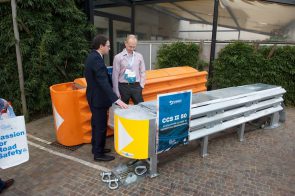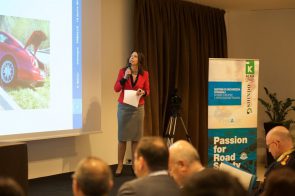PREALUX runs barrier safety event
First published in The Global Road Safety Review 2015 as Vehicle restraint systems
 Italian road safety technology specialist PREALUX recently ran an event presenting key issues for the market. This focused on vehicle restraint systems (VRS) and the differences between Italian and European rules. This event focussed on several key areas: single vehicle accidents; different VRS; characteristics of products and certification; Italian rules; particular cases; modifications.
Italian road safety technology specialist PREALUX recently ran an event presenting key issues for the market. This focused on vehicle restraint systems (VRS) and the differences between Italian and European rules. This event focussed on several key areas: single vehicle accidents; different VRS; characteristics of products and certification; Italian rules; particular cases; modifications.
Discussions looked in depth at incidents involving single vehicles leaving the carriageway. These are dangerous due to the risks posed by roadside obstacles and as a result, it is necessary to use passive protective devices such as barriers, crash cushions and end terminals to meet general requirements for safety.
In Europe, EN1317 is the standard governing assessment for VRS and presentations showed the present situation as well as ongoing developments.
The EN1317-1 portion covers vehicles used for tests and changes applied in the revision of the 1998 version. The EN1317-2 portion is for test conditions for barriers and different containment levels, severity indexes, deformations; changes introduced in the 2010 version, including addition of L classes. The EN1317-3 portion focuses on how a system works, redirective ability, test conditions matrix, classes of performance and severity indexes. It also covers a family of products made out of similar elements, starting from a parent tested unit.
The ENV1317-4 portion is a pre-standard for terminals, transitions, removable barrier sections. The TS1317-8 portion deals with motorcyclist protection systems for riders sliding on a road towards a barrier, including tests for different systems and acceptance criteria.
CE marking started from a new approach, finally delivering mandatory requirements for all EU countries. This included harmonised standards (hEN), a declaration of performance and allowed the use of the CE mark on products. Meanwhile the hEN covers methods and criteria to determine essential performances as mandated by the EU, and the Annex ZA specifies how to use it and how to apply CE mark. The hEN1317-5 for VRS resulted from work started in 1990, while there are strict procedures covering how a product can get a CE mark.
Changes to present standards are underway and the goal is to deliver greater unification of standards. The prEN1317-4:2014 standard covers different impact points for cars while the prEN1317-7:2014 standard is for terminals. For this last there are plans for a complete reorganisation with better identification of the installation position, different impact points and bigger test matrix.
For transitions there is an informative document showing different evaluation methods, including crash testing, virtual testing and calculations.
For the prEN1317-5:2014 standard the structure is being changed, with added test soil characterisation and classification of integrity.
A product modification procedure is being developed based on risk analysis.
Companies in this article
PREALUX






